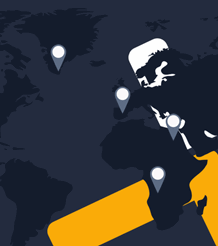
Belize Area Guide
Belize is considered to be BOTH a Caribbean and a Latin American country. Located with the Caribbean Sea to the East, Belize is bordered by Mexico to the North, and Guatemala on the South and West.
Belize has one of the lowest population densities in Central America, although the growth rate is one of the fastest in the Western Hemisphere. The population in 2012 was only 333.200 for the whole country, with the majority living in the larger cities of Belize City and Belmopan.
Up until 1981, Belize was considered a part of the United Kingdom (under the name of British Honduras) and still retains a strong colonial feel to this day.
Most visitors come to Belize to enjoy the fantastic Caribbean beaches, the rain forests, and the barrier reefs that are located right off the coastline. Belize has also become a “mecca” for eco-tourism in recent years.
Access to Belize is much easier than many travelers might believe – there are several flights every day from the U.S. on all major carriers, and you can reach Cancun from Corozal by car in just 3-4 hours. The highways connecting the different districts of Belize are in general of good quality, and travelling on your own in a rented vehicle is easy.
Traveling to Belize
Most visitors to Belize from overseas will enter via Phillip S. W. Goldson International Airport – also known as Belize City International. The airport is located in Ladyville, approximately 11 miles north of Belize City, along the Northern Highway.
The airport receives flights from all major U.S. airlines – as of April 2013, these are the destinations:
American – Miami and Dallas/Ft Worth Delta – Atlanta United – Houston and Newark US Airways – Charlotte
There is also International service by the following carriers:
Maya Island Air – Cancun, Guatemala City, San Pedro Sula Sunwing Airlines – Toronto-Pearson TACA – San Salvador TAG – Flores
There is also extensive domestic service by both Tropic Air and Maya Island Air, which connects islands and smaller villages with Belize City and the Capital. Many airports are not much more than a landing strip in the middle of a field, but flying can sometimes be quicker than driving.
The road quality varies a lot throughout the country – from the three “main” roads (Northern, Western and Hummingbird Highway) running across the country, to dirt tracks – Belize will never stop to amaze you. Travelling along the main highways is considered safe at all times of the day, though traffic can be very scarce in the evenings.
Some travelers also chose to fly into Cancun and drive (takes about 3-4 hours to Corozal town) and there is also a land border with Guatemala.
Citizens of the U.S., Canada, United Kingdom and any European Union country do not need any visa to enter Belize, and are granted an initial stay of 30 days at the point of entry.
No specific immunizations are needed for Belize, though Malaria tablets are recommended if visiting the rain forests, the southern part of the country, or spending extended periods of time in nature.
The People:
Culturally, Belize is a diverse melting pot.
By far the greatest number of settlers are the Mestizo (Spanish Indian) followed by Creole (African-European), Maya, Garifuna, Mennonites and recently an influx of European, North Americans and Canadians have made the country their home.
Bi-Lingual Population:
While English is the official language of Belize, a large number of the population will also speak Spanish, Creole, or a variety of other local and tribal languages.
Large expat community:
With its low cost of living and high quality of life, Belize property has become very popular with retirees. The country offers the only retirement visa in the Caribbean – the QRP – and this has allowed many new residents to settle in the country without having to make any large investments.
The Belizean Climate:
Belize has a tropical climate with pronounced wet and dry seasons, although there are significant variations in weather patterns by region. Temperatures vary according to elevation, proximity to the coast, and the moderating effects of the northeast trade winds off the Caribbean.
Average temperatures in the coastal regions range from 24 °C (75 °F) in January to 27 °C (81 °F) in July. Temperatures are slightly higher inland, except for the southern highland plateaus, such as the Mountain Pine Ridge, where it is noticeably cooler year round. Overall, the seasons are marked more by differences in humidity and rainfall than in temperature.
Rain forests, mountain retreats, stunning beaches and islands, as well as a mix of local cultures creates the perfect environment for eco-tourism, and related investments, to thrive. Many establishments in Belize are already using solar power, rain catchment systems, or private wells to supply water and energy, and this has proven to be very popular and appreciated by visitors.
The country is also home to some of the best fishing, diving, and hiking spots in the world, and has received lots of press and numerous awards over the years.
Time:
Belize is in Time Zone GMT -6, the same as U.S. central time. Belize does not observe Daylight savings time.
Economy:
Belize is widely recognized as a private-enterprise led economy, with very few restrictions on foreigners owning and operating businesses in the country. Very favourable tax laws and the ability to repatriate 100% of your earnings has made the country a very attractive base for financial service companies, the insurance industry, banks, as well as wealth management – but there are also opportunities available in a wide range of industries.
Healthcare in Belize
The Healthcare in Belize is improving constantly, and decent medical care can be found, particularly in metropolitan areas of Belize City. Many of the doctors are US trained and all speak English, and medical treatments cost a fraction compared to the United States.
Private health insurance is available and affordable in Belize, with doctors’ fees and hospital visits much cheaper than in many other countries, due to a low cost of living. As a result, prescription drugs are not expensive and often for sale simply over the counter.
For more complicated treatment, many expats choose to travel to Mexico or the U.S. and it is therefore recommended to keep an up to date medical insurance that covers this type of treatment – there are several options and this is the preferred choice for most expats and retirees.
Driving in Belize
Belize observes the same driving rules as the United States, and you can rent a car from any of the major rental car firms, who all have desks at the Belize City International airport.
Traffic can move at a very erratic pace once outside of the city – you can have someone pass you at 90 miles an hour, while you might also pass an old tractor at 15 miles an hour – speed limits are merely an indication once you leave Belize City!
For the most part, as Belize really doesn’t have any major metropolitan areas, drivers are pretty friendly and you are unlikely to ever find yourself stuck in any kind of rush hour traffic.
Belizean Cuisine
Belizean cuisine is a mixture of foods from all ethnicities in the country.
Breakfast consists of bread and flour tortillas that are often homemade, along with various forms of eggs or cereal, as well as milk, coffee, or tea.
Midday meals vary, from lighter foods such as rice and beans with or without coconut milk, tamales, panades, (fried maize shells with beans or fish) and meat pies), chirmole (soup), stew chicken and garnaches (fried tortillas with beans, cheese, and sauce) to various constituted dinners featuring some type of rice and beans, meat and salad or coleslaw.
In the rural areas meals may be more simplified than in the cities. The Maya use corn or maize for most of their meals, and the Garifuna are fond of seafood, cassava (particularly made into cassava bread or Ereba) and vegetables.
The nation abounds with restaurants and fast food establishments selling fairly cheap food. Local fruits are quite common, but raw vegetables from the markets less so. Mealtime is a communion for families and schools and some businesses close at midday for lunch, reopening later in the afternoon.
Crime and Police in Belize
Belize City has been known for having a large problem with drugs and crime, and has seen media from all across the world visit the city to report on this issue. However, as in most places in the world, unless you go looking for crime and problems you are unlikely to encounter them. Most of the crime in Belize City is gang-related and related to the drug trade, and the tourists are VERY well protected by a special police force.
In the more rural parts of Belize (essentially, anywhere outside Belize City) you are unlikely to encounter any serious crime at all – of course, crime happens everywhere so it is always advisable to exercise caution whenever in a public place, and also not to show excessive wealth as this can attract the wrong kind of attention.
You are likely to find the Belizeans very friendly and curious about you – even though tourism is growing rapidly, they are still getting used to meeting foreigners, and are excited to show you their country and help you whenever possible.



